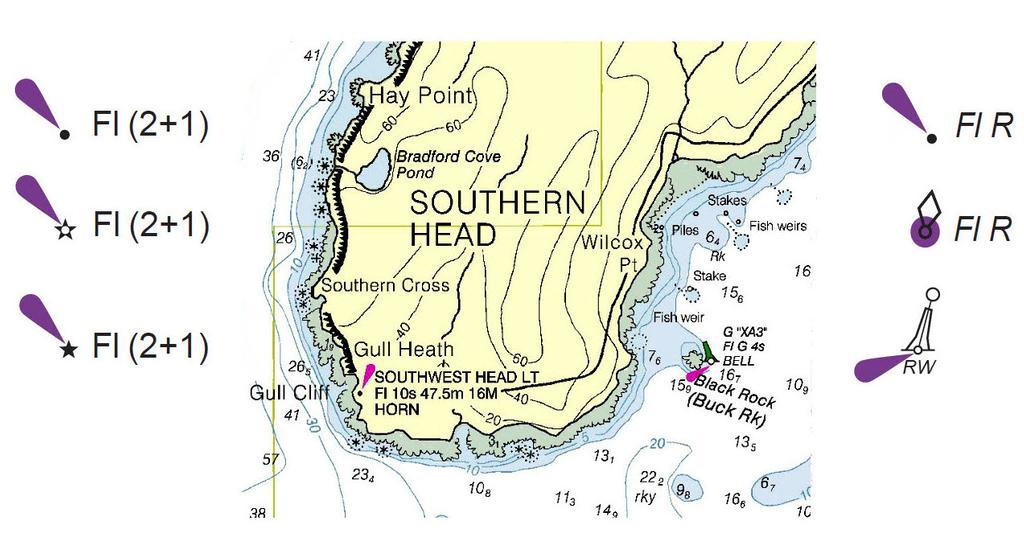Sailing Chart Symbol Secrets for Safer Navigation
by John Jamieson on 1 Mar 2014

This illustration is a clip from a National Oceanic and Atmospheric Administration (NOAA) chart (do not use for navigation) SW
Imagine sailing along a coastline with multiple lights along the shore. Your GPS has proved unreliable in this area. What chart symbol and abbreviation secrets will help guide you to safe landfall? Here are some navigation 'quick tips' on symbols that will help boost your navigation knowledge for safer sailing worldwide!
Scan any chart or plotter in the world and you can bet you will see an array of light symbols, lettering abbreviations and phrases and landfall descriptions. And it can confuse the saltiest mariner unless you break it down into just a few 'easy to digest' bits. Let's do that here with this small chart inset.
The more you can identify all the treasures you see on your nautical or electronic chart, the safer your sailing boat and her crew will be. Realize this fact--every line, word, letter, abbreviation, phrase, number, symbol and even color on your nautical chart or plotter has meaning.
Unlocking the Secrets of Letter and Light Symbols:
Vertical letters mean that the object or land mass does not change with the tide. Note the land mass letters are vertical, except in the description of Bradford Cove Pond (the water level might change with rainfall or in drought). Points carry bold letters if they are non-tidal.
Look at the aids to navigation descriptions on the left side of the illustration. All letters are vertical. This means one thing. These are fixed lights, either driven into the seabed (i.e. fixed pilings, I-beams, stone, or metal structures) or built onto the land (note the tall lighthouse named 'SOUTHWEST HEAD LIGHT'.
Note those aids to navigation on the far right side of the illustration. All letters are slanted, which signify floating aids to navigation. Most common are buoys, with the small open circle (instead of a black dot or black star). Buoys are air filled chambers with a large diameter chain attached to the bottom. They are anchored to the bottom with a large sinker--often concrete block--that can weigh tens of thousands of pounds. Indeed, buoys must 'maintain station' (stay on their assigned positions) in high winds, swell, waves, and storm conditions.
Other lights may be anchored to the bottom by an articulated mechanism that allows the light to sway with the wind or current. Again, theses aids to navigation move, so their symbol will be accompanied by slanted letters. Always.
Choose fixed structures first and foremost for sailing navigation if you have a choice. Shift to floating or articulated aids as a secondary choice. In all cases, use caution with any floating navigational aid.
In the Coast Guard, we found buoys off station (off the charted position you see on your nautical or electronic chart) time and again. Realize that buoys can drag off station, just like a boat can drag her anchor. It could take several days for a buoy tender crew to reset an aid onto charted position.
Take a look at the danger buoy off the southeast side of the point. Lighted buoy 'XA3' marks the deadly shoal just to the west and carries a flashing green four second light and a Bell. Note how this entire description has been slanted. It may seem subtle, but the more you use a chart, the easier it will become to interpret this vital feature.
Special Navigation Note:
Slanted symbols (the image and geometric shapes used to create the chart symbol) do not reveal whether the object will be fixed or floating. Cartographers (chart makers) slant symbols like buoys or lights to prevent clutter. Look to letters to reveal the secret as to whether the object you see has been fixed to the seabed or will float around a sinker on chain or sway on an articulated arm.
Use these sailing navigation secrets for safer sailing on the waters of the world. Put simple sailing tips like these into play aboard your sailboat to backup the GPS, increase your navigational safety, and boost your nautical knowledge when sailing or cruising on the waters of the world!
~~~~~~~~~~~~~~~~~~~~
John Jamieson (Captain John) with 25+ years of experience shows you the no-nonsense cruising skills you need for safer sailing worldwide. Visit his website at www.skippertips.com. Sign up for the Free, highly popular weekly 'Captain John's Sailing Tip-of-the-Week'. Discover how you can gain instant access to hundreds of sailing articles, videos, and 17+ Free e-Books!
If you want to link to this article then please use this URL: www.sail-world.com/119715